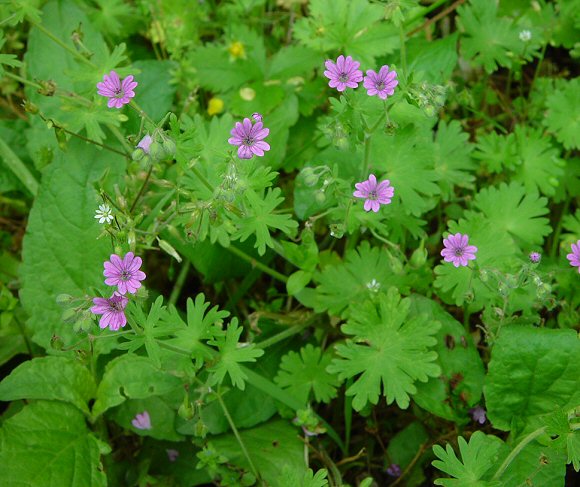Geranium molle L.
Dovesfoot Crane's Bill

Introduced
CC = *
CW = 5
MOC = 8
© DETenaglia
Geranium molle L.Dovesfoot Crane's Bill | |
 |
Introduced CC = * CW = 5 MOC = 8 |
© DETenaglia |
|
Family - Geraniaceae Stems - Multiple from the base, branching, herbaceous, erect to ascending, from a taproot, reddish at the base, terete, villous and glandular pubescent, to +/-40cm long.
Leaves - Alternate, stipulate, petiolate. Stipules oblique, attenuate to ovate, appressed pubescent and ciliate on the margins, to +6mm long. Petioles of the lowest leaves to +7cm long, petioles of the upper leaves much reduced. Petioles villous and glandular pubescent, terete. Blades 5-7 palmately lobed, orbicular, to +4cm in diameter, villosuous above and below, with ciliate margins. Lobes of the blades divided again. Ultimate divisions rounded to subacute, with a small reddish tip. Veins of the blade impressed above, expressed below. Main veins extending to the apex of the leaf and forming the minute tip.
Inflorescence - Axillary and terminal pedunculate umbels of 2-3 flowers. Peduncles to 2cm long, villous and glandular pubescent. Pedicels to 1.5cm long, villous and glandular pubescent, thickened at the apex for 2-3mm, each pedicel subtended by a small pair of bracts. Bracts reddish, ciliate, acute, 1-2mm long.
Flowers - Petals 5, distinct, 5-6mm long, 4-5mm broad, dark pink, glabrous but with a few cilia at the base, obovate, notched at the apex to about 1/3 of the total length. Stamens +/-10, erect. Filaments to +3mm long, compressed and wrapping around the ovary at the base, whitish at the base, purplish at the apex. Anthers purple, bilobed, -1mm long and broad. Styles 5, united for 1/2 their length basally, villous, purple at the apex, +/-3mm long in flower, accrescent. The apices spreading. Ovary superior, 5-carpellate, glabrous. Carpels raised rugose reticulate. Sepals 5, green, erect, villous and glandular pubescent externally, antrorse appressed pubescent internally, elliptic-oblong, 3-4mm long in flower, +/-2mm broad, entire, acute and with a minute hardened tip to .2mm long, accrescent.
Flowering - May - August. Habitat - Lawns, grassy open ground, roadsides. Origin - Native to Europe. Other info. - This weedy species is uncommon in Missouri but will almost certainly spread with time. The plant is attractive but can be aggressive if left unchecked. This species can be identified by its glabrous carpels, pinkish flowers (which have deep notches in the petals), pubescent stems, and simply acute sepals. Photographs taken somewhere in NC., 4-20-03, and on the Auburn University Campus, Auburn, AL., 3-26-05. |